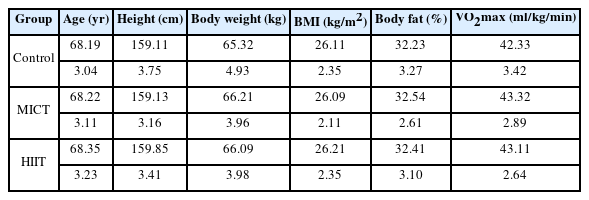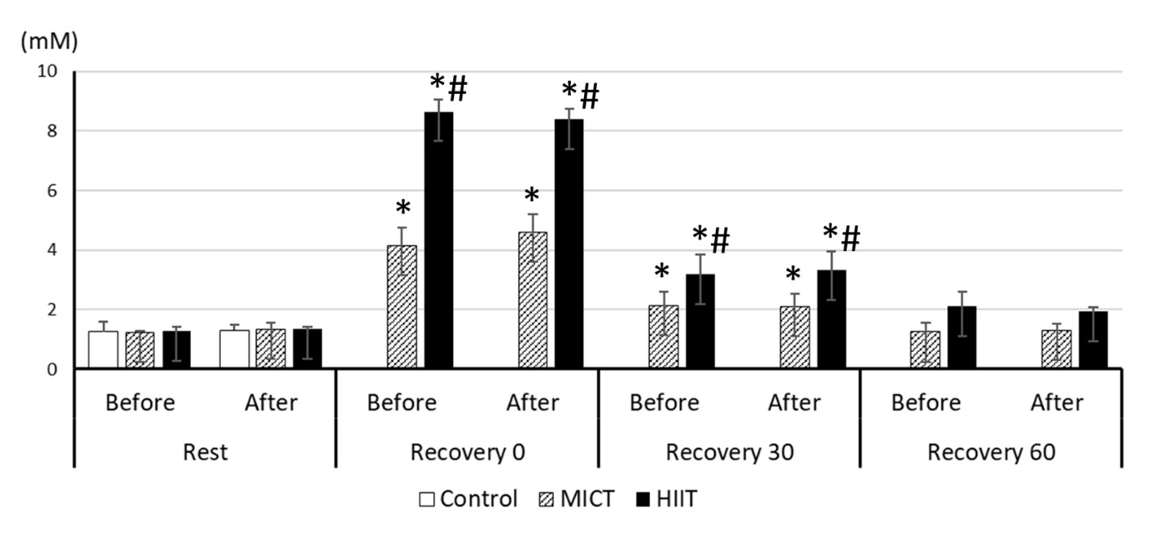Effects of 12 Weeks of Moderate-intensity Continuous Exercise and High-intensity Interval Exercise on Cognitive Function in Elderly Subjects
Article information
Abstract
OBJECTIVES
This study analyzed the possibility of brain function activation after exercise training of high-intensity interval exercise and moderate-intensity continuous exercise in elderly people.
METHODS
The subjects of the study were elderly female people aged 65 years or older and were divided into three groups : control group, moderate-intensity continuous training (MICT), and high-intensity interval training (HIIT). Changes of body composition, physical fitness, cognitive function, and cognitive function-related blood variables were compared between before and after 12 weeks of exercise training.
RESULTS
Body weight, BMI (body mass index), and WHR (waist hip ratio) of body composition in HIIT group decreased significantly (p<0.05) after exercise training, and there was no significant difference in MICT group and the control group. HIIT group significantly (p<0.05) improved in grip strength, muscular endurance, flexibility, balance, cardiorespiratory endurance, and walking ability after exercise training, while MICT group showed significant (p<0.05) improvements only in flexibility, balance, and cardiorespiratory endurance. Regarding blood variables, HIIT group showed significant (p<0.05) differences in BDNF (brain-derived neurotrophic factor), irisin, and β-amyloid after exercise training, MICT group showed significant (p<0.05) differences only in β-amyloid. Cognitive function in HIIT group and MICT group significantly (p<0.05) improved in terms of temporal and spatial orientation, memory, and total scores after exercise training. During the recovery phase after one session of high-intensity interval exercise, blood lactic acid concentration increased significantly.
CONCLUSIONS
This study was confirmed the possibility of giving that high-intensity interval exercise for the elderly not only produces positive changes in body composition and improves physical fitness and cognitive function, but also frequently stimulates lactate production, helping to activate brain function through changes in BDNF and irisin in the blood.
Introduction
The effect of exercise is widely recognized as a key factor in the process of suppressing the occurrence of diseases to maintain health through positive factors including improvement of physical fitness and activation of immune function [1]. In particular, the positive effect of maintaining health through exercise is even more important in the process of preventing aging, which is a representative risk factor for health. Recently, in relation to the need for exercise programs for the health management of the elderly, the possibility that muscle contraction during exercise can improve cognitive function by helping to express brain function activation factors has been suggested [2]. Therefore, exercise was considered to be an effective way to prevent cognitive decline that occurs during the aging process and to prevent dementia. From this perspective, analyzing the detailed mechanisms related to the expression of brain growth factors in skeletal muscle and the possibility of improving brain function according to exercise programs for the elderly is important for further increasing the value of exercise. In the past, lactic acid accumulation within the muscles as adequate oxygen supply was restricted during excessive exercise above a certain level, which made insufficient oxygen supply, was considered to act as a metabolic obstacle or as a cause of metabolic acidosis and local muscular fatigue [3,4]. However, lactate produced during recent exercise is considered capable of playing a new role what activates lipid metabolism [5,6], brain angiogenesis through the lactate receptor hydroxycarboxylic acid receptor 1 (HCAR1) and improving cognitive function through activating the expression of brain-derived neurotrophic factor (BDNF) in the hippocampus [7-9].
As a new role related to activating the physiological function of lactate produced during high-intensity exercise [10] has been proposed, artificial administration of lactate to improve exercise capacity is also being considered [11], and in view of the positive effects of the lactate produced during exercise is being considered. There has been much interest in ways to induce the activation of lactate production by performing specific exercise programs, including high-intensity exercise above a certain level [12]. In addition, a detailed analysis is required to determine what factors or processes causes lactate produced during exercise to affect brain function activation [13]. The process that causes an increase in BDNF related to brain function activation by lactate produced during exercise involves molecular biological pathways of the hippocampus centered on monocarboxylate transporter-2 (MCT2), which is presented as a transporter, and G-protein-coupled receptor (GPR81), which is presented as a receptor are the most representative ones [14]. Lactate, an endogenous metabolite produced during exercise, is produced from muscles during exercise, secreted into the blood, and supplied to nerve cells by astrocytes. In this process, it passes through the blood-brain barrier (BBB) through MCT2 and is supplied to the brain, including the hippocampus. The increase in MCT2 levels in the hippocampus during exercise is related to the increase in BDNF and TrkB signaling systems [15]. Increased lactate during exercise activates silent information regulator sirtuin 1 (SIRT1), and it is known to increase BDNF through the peroxisome proliferator-activated receptor-γ coactivator-1α/fibronectin type III domain-containing protein 5 (PGC-1α/FNDC5) pathway in the hippocampus [11]. However, the more obvious mechanisms remain unclear.
As mentioned above, the need for high-intensity exercise for the elderly has recently been emphasized as the lactate produced during exercise and the possibility of activating brain function have become a topic of interest with the lots of evidence. During high-intensity exercise, the possibility of an increase in lactate accumulating in the body increases [16], increasing lactate in muscles can help activate BDNF expression in the hippocampus [17,18]. Therefore, even in the elderly, there is a need for high-intensity interval exercise and resistance exercise to increase lactate production in relation to the activation of BDNF expression in the hippocampus [19,20], but it is a need to clearly confirm the positive effects [21-23]. Although the relationship between increased lactate accumulation and increased blood BDNF concentration as exercise intensity increases [24-26] has been widely reported, because the analysis results of the effect of high-intensity exercise are still insufficient, there is a need to analyze the level of lactate production and BDNF expression in the brain and hippocampus according to exercise intensity in elderly people, and the results will be important information for preventing dementia caused by aging.
This study compared the possibility of increasing lactate production and activating brain function through exercise training focusing on high-intensity interval exercise and moderate-intensity continuous exercise in elderly people.
Methods
Subjects
The subjects of the study were 30 healthy elderly female people who were able to exercise at a senior welfare center located in D City. They were selected as a control group (n=10), a moderate-intensity continuous exercise group (n=10), and a high-intensity interval exercise group (n=10) were divided into three groups, and each exercise program was performed four times a week for 12 weeks. The number of study subjects was determined by referring to a similar previous study using the G power 3.1.9.2 program and testing the difference between the means of the two groups based on the effect size of 0.62, power of .80, and significance level of .05. As a result, the minimum sample size required for each group was 8, and the actual test power was 0.97. Considering the dropout rate of more than 20% that occurred in previous studies, a total of 30 subjects, 10 per group, were selected. The physical characteristics of the study subjects are as shown in <Table 1>. This study was approved by Institutional Review Board of Keimyung University (40525-202201-BR-098-02).
Exercise program
The study subjects adapted to treadmill walking and bicycle ergometer exercise for one week before the experiment and then performed this exercise. The exercise frequency was performed 5 times per week with three treadmill (Davis Medical Electronic Inc, Vista, CA, USA) exercise and 2 bicycle ergometer (COSMED, Albano Laziale, Italia) exercise for 12 weeks. The exercise intensity was determined by analyzing VO2 max using a respiratory gas analyzer (Davis Medical Electronic Inc, Vista, CA, USA) during exercise on a treadmill and bicycle ergometer and then setting the appropriate intensity. The control group performed exercises focusing on stretching for 45 minutes, and the medium-intensity continuous training (MICT) performed treadmill exercise and bicycle ergometer exercise as a warm-up for 10 minutes each, continued for 45 minutes at 40-60% of maximum exercise intensity, and then exercised for 5 minutes cool down. The high-intensity interval training (HIIT) performed treadmill exercise for 10 minutes as a warm-up, followed by 1 minute at an intensity of 85% or more of the maximum exercise intensity, and then performed 6 repetitions of 40% of the maximum exercise intensity during a 4-minute recovery period. Bicycle ergometer exercise consisted of a 10-minute warm-up, followed by an interval exercise of 4 minutes of high-intensity bicycle pedaling (≥85%) and 3 minutes of rest (pedaling at no load), repeated 4 times, followed by a 5-minute cool down. During individual exercise, blood lactate concentration was measured using a lactate analyzer (YSI 1500, YSI, Yellow Springs, Ohio, USA) at resting times, immediately after one exercise, and 3 and 5 minutes during the recovery period at 4-week intervals.
Measurement item and experimental procedure
◦ Blood collection at rest : After fasting for 12 hours before blood collection, the subjects arrived at the laboratory by 9 a.m., rested, and then a nurse waiting in advance collected 10 ml of blood through the brachial vein. The collected blood was treated with heparin to prevent coagulation, centrifuged at 3000 rpm for 10 minutes to separate plasma, and stored frozen at -80°C until analysis. Blood collection was conducted twice before and after the exercise program.
◦ Physique and body composition : Height was measured using a stadiometer (YKK, Tokyo, Japan), and weight and body composition were analyzed using InBody 5.0 (Biospace, Seoul, Korea). Physique and body composition measurements were conducted twice before and after the exercise program.
◦ Physical fitness tests include the Harvard Step Test for cardiovascular fitness, sitting and bending forward for flexibility, grip strength for muscle strength, sitting and standing from a chair for muscular endurance, timed up and go test (TUG) for agility and coordination, and 8 m walking ability test was measured. Physical fitness measurements were conducted twice before and after the exercise program.
◦ Dementia test : The Korean version of the Mini-mental Status Examination (MMSE-K) was conducted to measure orientation, memory ability, memory recall, attention and calculation, language function, comprehension, and judgment ability. Dementia testing was conducted twice before and after the exercise program.
◦ Blood analysis : Blood BDNF, irisin, tau, and β-amyloid concentrations were analyzed by immunoassay using an ELISA Kit (Sigma Aldrich, St. Louis, Missouri, USA).
Statistical analysis
Statistical analysis was performed using SPSS version 24.0 (IBM SPSS Statistics, Chicago, IL, USA). Two-way repeated ANOVA was performed to evaluate the significant differences between the groups and the periods, followed by post hoc test, when significant differences were found: one-way ANOVA and independent t-test between groups by period and the paired t-test between periods by group. All data were described as mean±standard deviation, and the statistical significance level was set at p<.05.
Results
As a result of comparing changes in body composition after 12 weeks of exercise training in elderly women over 65 years of age in <Figure 1>, the high-intensity interval exercise group showed a significant (p<0.05) decrease in body weight, BMI, and WHR after exercise training, while the medium-intensity continuous exercise group and the control group showed no significant difference.
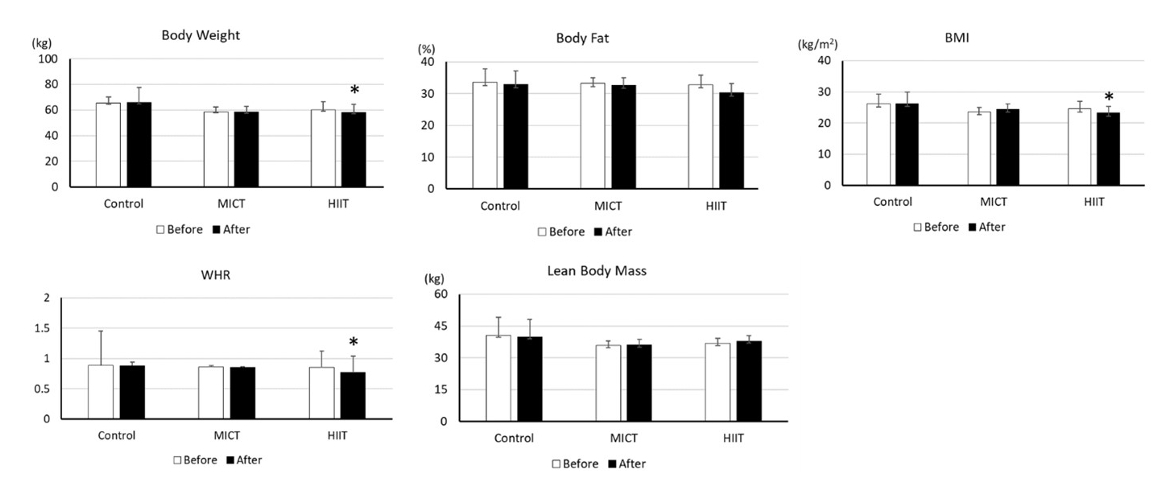
Changes of body composition after 12 weeks exercise training (*p<.05 Compared to before exercise training; MICT, moderate-intensity continuous training; HIIT, high-intensity interval training).
As a result of comparing changes in physical fitness after 12 weeks of exercise training in <Figure 2>, the high-intensity interval exercise group showed significant (p<0.05) improvements in grip strength, muscular endurance, flexibility, balance, cardiorespiratory endurance, and walking ability after exercise training, while the medium-intensity continuous exercise group showed significant (p<0.05) improvements only in flexibility, balance, and cardiorespiratory endurance.
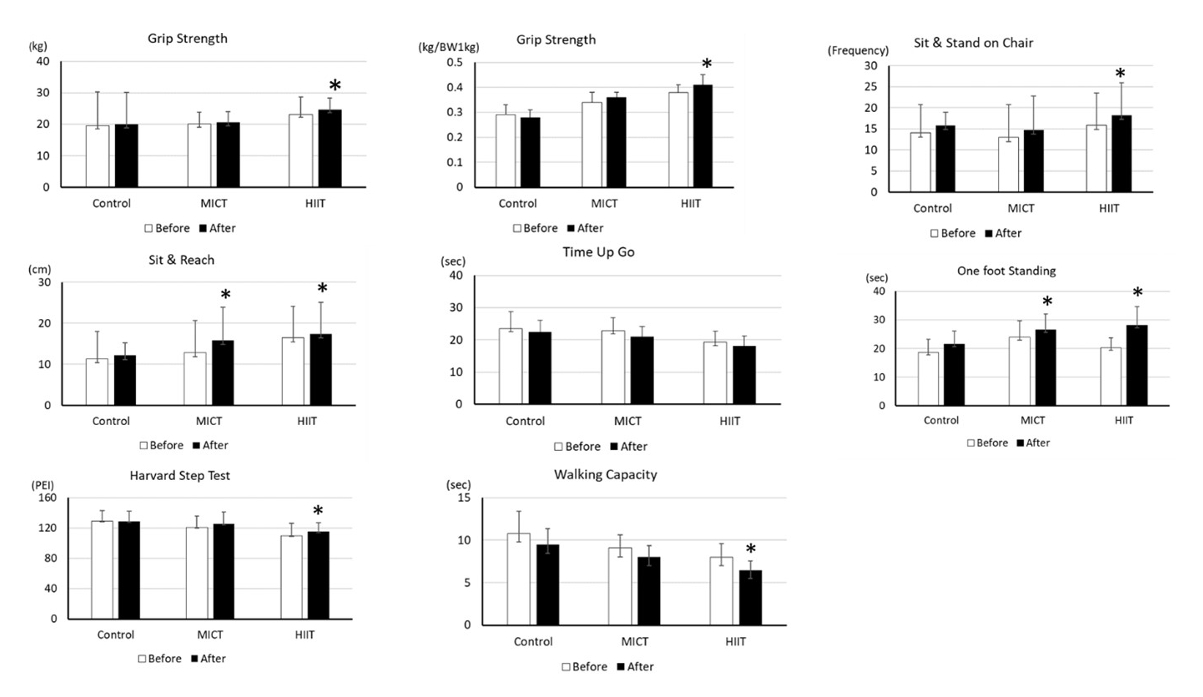
Changes of physical fitness composition after 12 weeks exercise training (*p<.05 Compared to before exercise training; MICT, moderate-intensity continuous training; HIIT, high-intensity interval training).
As a result of comparing changes in blood variables after 12 weeks of exercise training in <Figure 3>, the high-intensity interval training group showed significant (p<0.05) differences in BDNF, Irisin, and β-amyloid after exercise training, and the medium-intensity interval training group showed significant (p<0.05) differences only in β-amyloid.
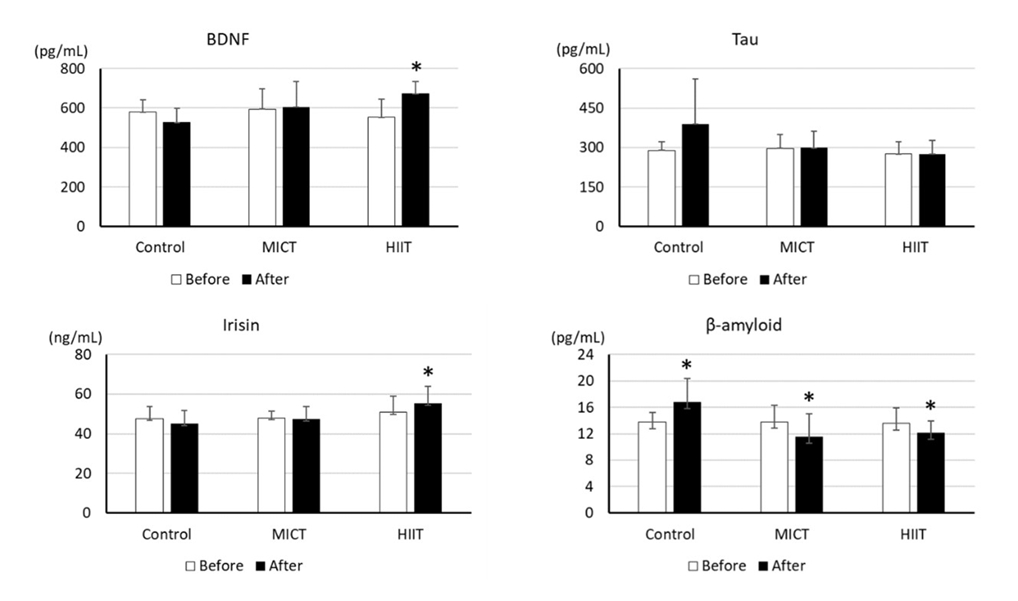
Changes of blood concentration of parameter related to cognitive function after 12 weeks exercise training (*p<.05 Compared to before exercise training; MICT, moderate-intensity continuous training; HIIT, high-intensity interval training).
As a result of comparing changes in cognitive function after 12 weeks of exercise training in <Figure 4>, the high-intensity interval training group and the medium-intensity exercise group showed significant (p<0.05) improvements in temporal and spatial orientation, memory, and total after training group.
Discussion
Looking at changes in body composition, the high-intensity interval training group showed a significant decrease in body weight, BMI, and waist circumference after 12 weeks of exercise, while the control group and the moderate-intensity continuous training group showed no significant difference. Considering that the subjects in this study were elderly and obese, high-intensity interval training is considered to have had a positive effect on body composition. In general, continuous exercise has been widely applied as exercise type that focuses on the positive effects related to the body composition of the elderly, but recently, high-intensity interval exercise has been used in terms of maximum oxygen intake and muscle function activation, including increased oxygen consumption in the recovery period after exercise [27,28]. High-intensity interval exercise allows you to repeatedly experience lactic acid accumulation by repeating high-intensity exercise with short rest periods, whereas continuous exercise has limitations in experiencing high lactic acid accumulation because exercise cannot be continued when lactic acid accumulation occurs, and it also makes difficult to increase the amount of exercise [29]. Therefore, in addition to the positive effects on body composition, the possibility of using high-intensity interval exercise can be suggested from the perspective of providing the experience of lactic acid accumulation, which was the main focus of this study. Of course, considering the difficulties of high-intensity interval exercise, there are difficulties in easily applying it to the elderly, but recently, the importance of high-intensity interval exercise for the elderly has been more emphasized [30]. In particular, sarcopenia, which is considered a negative change in the body composition and perspective of the aging process, occurs mainly in fast-twitch fibers (type II) and is accompanied by a decrease in muscle strength and an overall decrease in physical performance [31]. Therefore, it is considered a risk indicator related to the increase in the prevalence of frailty and various metabolic diseases. To prevent aging, an exercise program that maintains exercise intensity as high as possible, along with high-intensity resistance exercise that focuses on activating muscle functions, including maximal strength, along with positive maintenance of body composition that focuses on increasing muscle mass [32] relatively more importance should be given to older people than to young people [33].
The effect of improving physical fitness through regular exercise has already been widely recognized through existing research. In the process of performing exercise, moderate intensity exercise is effective, and excessive high intensity exercise should take into account negative effects such as the possibility of causing myocardial infarction and excessive production of reactive oxygen species [34]. In particular, since the subjects of this study consisted of elderly people, the possibility of negative factors due to the risks of high-intensity interval exercise was also considered. However, looking at the changes in physical fitness after 12 weeks of exercise training in this study, the high-intensity interval exercise group showed improvements in most physical fitness factors, including muscle strength and walking ability, but the medium-intensity continuous exercise group showed improvements in cardiorespiratory endurance, balance and flexibility. These results have recently widely emphasized the possibility of using high-intensity exercise to reduce blood pressure and prevent and alleviate metabolic diseases in the process of applying exercise programs [35,36], and also were consistent with the results of previous studies that reported positive effects from high-intensity interval exercise not only in elderly [37,38] but also in elderly diabetic patients [39].
Fatal prognoses related to the decline in brain function during the aging process include significant decline in memory and cognitive function due to Alzheimer’s disease and dementia. In particular, Alzheimer’s disease is caused by aging, genetic family history, decreased neuronal synapse function, and traumatic brain damage, and increased deposition of β-amyloid was considered to be the main factor [40], but the cause is still unclear. It is difficult to prevent and treat Alzheimer’s disease due to one cause. Pathological symptoms related to the decline in brain function during the aging process include hippocampal atrophy and degeneration, microglial activation, neuroinflammation, and nervous system apoptosis. Secondary risk factors include diabetes and hypertension, obesity, smoking, depression, and inactivity. Therefore, physical activity and exercise have the potential to alleviate brain function decline by increasing cerebral blood flow, brain mitochondrial content, and hippocampal size, and improving neuroplasticity [41]. β-amyloid, which showed significant changes after exercise training in this study, has been considered an important factor in the slowing of brain function and the possibility of causing dementia. β-amyloid has been considered a key risk factor or symptom indicator in the significant decline in brain function during the aging process and in the development of dementia and Alzheimer’s disease [40], and exercise can be considered effective in alleviating the accumulation of increased β-amyloid as the risk of brain function decline or dementia during the aging process [19]. Therefore, it was confirmed that both high-intensity interval exercise and medium-intensity continuous exercise applied in this study can have a positive effect on improving brain function by reducing the concentration of β-amyloid in the blood.
De la Rosa et al. [42] and Ryan & Kelly [43] have argued that exercise is a representative non-pharmacological treatment method for delaying or alleviating Alzheimer’s disease, and Cass [44] and Dehghan et al. [45] argued that exercise can help improve cognitive function in aging and Alzheimer’s disease patients, alleviate neuropsychiatric disease symptoms, and improve overall life. As the positive effects of such exercise have been widely reported, interest has grown in the specific effect mechanism of exercise as well as which exercise type is more effective. Pahlavani [46] reported that aerobic exercise mainly alleviates the decrease in the size of the hippocampus, activates neuroplasticity, increases blood flow and blood flow distributed in the nervous system, reduces the secretion of inflammatory cytokines in brain tissue, and increases BDNF and irisin, and combined exercise programs such as aerobic exercise, resistance exercise, coordination and balance maintenance exercise were reported to be effective.
In this study, the high-intensity interval exercise group and the medium-intensity continuous exercise group showed significant (p<0.05) improvements in temporal and spatial orientation, memory, and sum total after exercise training, without significant effect in language ability, attention concentration, and calculation ability. High-intensity interval exercise and moderate-intensity continuous exercise applied in this study showed the same positive effects on some factors of cognitive function, so differences in exercise type could not be clearly identified. Although the types of exercise applied in this study differ in intensity and duration, both can be considered forms of aerobic exercise, and it was clearly confirmed that aerobic exercise can help improve brain function.
Although the mechanism of exercise effect on brain function shown in this study is a blood factor, its basis can be presented from the changes in variables related to blood brain function in the two groups that performed exercise in this study. In this study, after 12 weeks of exercise training, the high-intensity interval exercise group showed significant (p<0.05) differences in blood BDNF, irisin, and β-amyloid after exercise training, and the medium-intensity continuous exercise group showed significant (p<0.05) differences only in β-amyloid. Blood BDNF and irisin concentrations significantly decrease during the aging process and are associated with a decline in brain function due to a decrease in neuronal plasticity in brain tissues such as the hippocampus, limbic system, and striatum [47], and it is known that patients with Alzheimer’s disease exhibit a decrease in BDNF expression along with a decrease in brain function caused by β-amyloid and oxidative stress [48]. It has been widely reported that blood BDNF concentration can help restore brain function that deteriorates during the aging process by increasing aerobic exercise [49,50]. Irisin is a myokine secreted from muscles in response to exercise and is involved in regulating homeostasis of the nervous system. It also appears around the ventricle of brain tissue or in cerebrospinal fluid [41,51]. Additionally, irisin acts on the central nervous system through the blood-brain barrier and acts to increase BDNF to activate cognitive and memory functions [52]. In particular, as exercise is known to have positive effects, the organic process of exercise-irisin-BDNF has been suggested to have a positive effect on the activation of nervous system plasticity [53]. The high-intensity interval exercise group applied in this study showed significant increases in both blood irisin and BDNF concentrations after exercise training, suggesting that high-intensity interval exercise activates the organic relationship between exercise-irisin-BDNF relatively more than moderate-intensity continuous exercise. In this process, the mediating action of lactate can be estimated.
The main focus of this study was to examine the possibility that high-intensity interval exercise performs repetitive exercise at high intensity, resulting in a relatively significant increase in blood BDNF and irisin concentrations due to repeated stimulation of lactate accumulation in the body compared to medium-intensity continuous exercise. In this study, because only blood variables were analyzed, it is difficult to confirm a direct causal relationship, but only the high-intensity interval exercise group showed a significant exercise training effect on blood BDNF and irisin concentrations. Therefore, the possibility of increasing blood BDNF and irisin concentrations through high-intensity interval exercise in elderly people was fully confirmed. The fact that the effect of exercise training on blood BDNF and irisin concentrations showed a clear difference between the high-intensity interval exercise group and the medium-intensity continuous exercise group can be seen as a result of repeated opportunities to increase lactate through high-intensity interval exercise. <Figure 5>, it is thought that high-intensity interval exercise can have a positive effect on brain function through lactate accumulation, as it shows a significantly high increase in blood lactate concentration during the recovery process after acute exercise. Recently, the possibility of activating BDNF and irisin secretion due to an increase in metabolic factors including lactate through repetitive exercise has been widely reported [54,55], so the possibility of increasing BDNF and irisin in the blood and improving brain function through high-intensity interval exercise in this study can be fully supported.
Conclusion
This study was confirmed the possibility that high-intensity interval exercise for the elderly not only resulted in positive changes in body composition and improved physical fitness and cognitive function, but also helped activate brain functions such as BDNF and irisin in the blood through frequent exercise stimulation of lactate production.
Acknowledgements
This work was supported by the National Research Foundation of Korea (NRF) grant funded by the Korea government (MSIT) (No. 2020R1F1A1072018).
Notes
The author declare no conflicts of interest.

